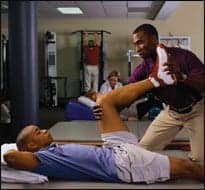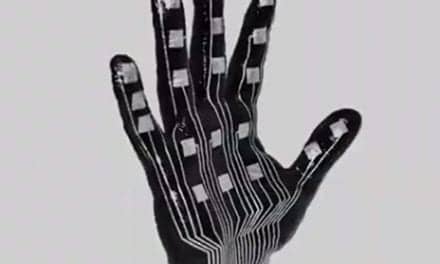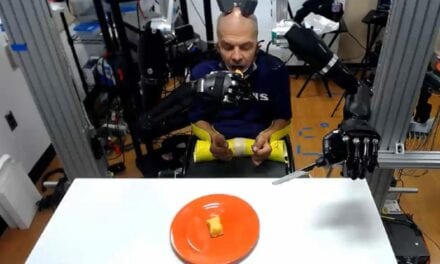 |
| Clients with lower-extremity issues benefit from a myriad of physical therapy modalities. |
Physical therapists rely on rehabilitation therapies and modalities for lower-extremity post-sports injury treatments involving the knee, ankle, and musculoskeletal strains/bruising/injury. Methods include continuous passive motion (CPM), stabilization, resistance exercises and strength training using bands and balls, ankle foot orthoses (AFOs) and other orthoses, knee bracing, anterior cruciate ligament (ACL) rehab, and, for those who have had a limb amputated, prosthetics.
THE BENEFITS OF CONTINUOUS PASSIVE MOTION
CPM use is helpful during the first postoperative week after knee surgery because it helps prevent a hemarthrosis by keeping the knee elevated above the heart, says Heather Freeman, PT, DHS, Shelbourne Knee Center, Indianapolis. Prevention of a hemarthrosis helps reduce postoperative pain and allows patients to regain flexion range of motion (ROM) more quickly, she says.
Alan Tomasko, PT, ATC, CSCS, Department of Kinesiology, Biomechanics Laboratory, University of Massachusetts, Amherst, says the use of CPM as part of an overall treatment plan can have a positive impact on a number of treatment goals—including earlier return of range of motion, decreased potential for DVT, decreased edema, increased natural lubrication of the affected joints, and pain modulation. “Each of these benefits improves the patient’s functional baseline, thus providing the opportunity for the therapist to more efficiently use their time incorporating more skilled manual procedures and advancing exercise protocols and functional exercise tasks,” he says. “The application of CPM can be effective as a modality both pre- and post-therapy intervention.”
In considering the cost benefit of CPM intervention, Tomasko says therapists cannot just look at the overall cost of the rehabilitation course. “The choice of implementing CPM in therapy will have a positive impact on how the therapist spends their direct hands-on intervention time with the patient, allowing them to work on higher-level manual procedures, exercises, and functional skill sets,” he says. “Additionally, one should consider the overall cost of rehab to include costs not usually considered. There is a cost to other family members for the time required to assist a patient if they are functionally limited … and there can be costs for the hiring of outside health aides, complications due to reduced mobility, and any lost productive work time.”
The number one problem with motion is it needs to be consistent—so therapists want to have a consistent speed with which they are moving the joints, a consistent range of motion they are moving them through, and a consistent force being applied to the joints, says Bruce A. Graham, ATC, CFo, CSCS, clinical specialist, orthotics and CPM, who works for a company that furnishes the devices. “When I’m doing therapy on somebody, as I begin to fatigue, I’m going to move the joint a shorter range of motion, I’m going to slow down, and I’m not going to apply as much resistive force as I move the joint—whereas with a machine, all of that is calibrated.” The speed of the CPM device, how hard it pushes, and its full range of motion can be programmed for hours, he says.
CPM never replaces the therapist or physical therapy; it is used in conjunction with the therapy regimen, says Graham. He says, typically, for most knee rehab, patients use the device for about 2 to 3 hours, two to three times a day. The aim is to stimulate cartilage regrowth. “If you do a microfracture technique or an OATs (osteoarticular transplant) procedure to repair articular cartilage, or if you do a Carticel implant (autologous chondrocyte transplantation) of injecting new cartilage cells into the area, those are all, by protocol, at least 6 to 8 weeks of CPM machines,” says Graham. Moving a joint also helps to reduce postoperative edema, pain, and stiffness, which increases the patient’s range of motion; movement of the joint or lower limb in general will help overall circulation, which may reduce the occurrence of deep vein thrombosis, he says.
STABILIZATION, STABILITY PAD, BANDS AND BALLS
Some research at the Nicholas Institute of Sports Medicine and Athletic Trauma (NISMAT), Lenox Hill Hospital, New York, focuses on preventing injuries. Tim Tyler, MS, PT, ATC, who treats patients and is a clinical research associate at NISMAT, says high school athletes were able to decrease the incidence of ankle sprains by standing on a stability pad, a balance device made of foam, for 5 minutes per ankle, three times a week, for 6 weeks during the preseason. Tyler says he believes the activity strengthens the muscles around the ankle joint, helping athletes to react to unstable surfaces in real life, such as stepping on a foot or into a hole, or being trapped on the turf.
Patients who visit the Institute range from conditioned high school and professional athletes to unconditioned middle-aged and older weekend warriors, whose injuries include ankle sprains, knee injuries, ACL injuries, cartilage/meniscus injuries, muscle strains, adductor strains, hip strains—and a new one known as the A-Rod injury, femoroacetabular impingement.
Balance training with bands and balls plays a role in the treatment regimen. Choosing an amount of resistance that corresponds to patients’ goals is key. “If you’re looking to create muscle contraction and proprioceptive facilitation, you need to choose an appropriate resistance,” he says. “For a small, young gymnast, you might use the lightest band color—yellow. For a big football player, you might have to go right to the black band, which is one of the heavier bands.”
Bands are also useful for rehabbing smaller joints that have less ROM. “We can cut and fit a band—we do exercise with the great toe, where we have the person strap the band around the big toe and work that little muscle joint,” Tyler says. Therapists vary the amount of resistance and reps between exercises, based on the severity of the injury. “The soleus muscle is a Type I muscle; it is a slow-twitch fiber we use when we’re jogging or walking. We’ll train that with high repetitions and a low load, to make it fatigue-resistant,” says Tyler. “The gastrocnemius is a Type II muscle, a fast-twitch muscle, which we’ll train with maybe some heavier resistance and less repetitions. We’ll try to get some power out of that muscle.”
Melissa F. Carlton, PT, CSCS, CATZ Physical Therapy Institute, Pasadena, Calif, says she has been very successful with Kinesio tape for edema reduction and pain relief, and for stabilization purposes. ”Kinesio tape has been very useful with acute ankle sprains, total knee replacements, and postoperative arthroscopies. I have had some chronic pain cases with a lot of edema that have had almost instantaneous results with Kinesio tape for edema relief.”
ORTHOSES AND TAPING APPLICATIONS
Individual patient cases vary, but orthotics may be useful therapeutic adjuncts because they redistribute the forces across the foot and can provide relief to overstressed tissues, says Freeman. With overuse injuries, it is critical to minimize the stress placed on injured tissues to allow the healing process to begin, she says. “I like to use taping techniques first to determine the patient’s response, and if the taping provides relief, I will fit the patient with an appropriate orthotic,” Freeman says.
The highest volume of prescriptions for orthotics at The Emory Center for Rehabilitation Medicine (CRM), Atlanta, are for clients who have a neurologic disease or disorder, says Tami Phillips, PT, DPT, MBA, physical therapy supervisor at the facility. “Loss of dorsiflexion in these patients is usually a result of flaccid paralysis or low muscle strength in the dorsiflexors; or high tone in the gastroc-soleus complex,” she says. “Some clients have had local compression or traumatic damage to the peroneal nerve at the fibular head, while others may have an unstable ankle joint as a result of an injury or disease process.”
THE USE OF FOOT ORTHOTICS
The four most common types of ankle foot orthoses used at CRM are solid ankle, articulated ankle, posterior leaf spring, and the Allard Ypsilon or Toe-Off, says Phillips. “We have also been using neuroprostheses for patients with upper motor neuron disease,” she says. “These use functional electrical stimulation systems to stimulate the peroneal nerve, resulting in contraction of the muscles that dorsiflex and evert during gait.” One system times the contraction based on tibial position during gait, while another is a wireless system that uses a heel switch to determine the timing of dorsiflexion/eversion during the gait cycle, she says.
Solid ankle AFOs are rigid and not articulated, making them appropriate if the ankle and/or knee is unstable or in the case of severe spasticity. Posterior leaf springs are not articulated, but are far less rigid, providing a small amount of dynamic response during push-off, she notes. “An articulated ankle allows for some ankle motion, dorsiflexion assist, or push-off during gait,” says Phillips. One type of brace used at the facility was created so the body of the brace is anterior over the tibia and the carbon composite material absorbs energy at heel strike and returns it at toe-off. Paired with a foot orthotic, it is lighter and allows movement at the calcaneus in response to the ground producing a more normal gait pattern, Phillips says, noting that it is used most often for individuals with mild to moderate foot-drop and/or ankle instability.
“A variety of foot orthotics may be prescribed for patients who have partial foot or toe amputations, instability and/or pain in the various joints of the foot, plantar fasciitis, or leg length discrepancy,” she says. “Orthotics can be made to support the remaining foot and fill empty shoe space in the case of forefoot amputations, to support a normal foot position in the case of metatarsalgia, or lift the heel to correct a minor leg length discrepancy.”
KNEE BRACING
Knee bracing is also done for patients at CRM who have orthopedic and neurologic conditions, says Phillips. Hinged knee braces are most common for a variety of elective knee surgeries, as they can be locked into various degrees of flexion and extension, she says. “Knee immobilizers are still issued for most of the total knee arthroplasty patients to promote knee extension and provide some stability during bed mobility and gait,” Phillips says. “We use knee immobilizers or a custom-made knee extension orthotic for transtibial amputees in order to prevent flexion contractures and protect the residual limb from being bumped, resulting in poor healing or injury to the incision.” Specific braces are often used by therapists at the facility to control hyperextension of the knee as a result of a neurologic injury or genu recurvatum due to ligament laxity and instability. Knee-ankle-foot orthoses (KAFOs) are used when instability and/or weakness is present in both the knee and ankle, making standing and ambulation difficult, says Phillips. The knee joints of a KAFO are hinged and can be locked into extension as needed; and the ankle can be solid or articulated as well.
ACL THERAPEUTIC PROGRAMS
The single most important factor affecting outcomes of ACL reconstruction is ROM, particularly extension ROM, says Freeman. “Many clinicians seem to overlook the importance of hyperextension, but knee hyperextension is normal and is present in approximately 95% of healthy knees,” she says. “The goal should be to achieve range of motion that is symmetric to the normal knee, including hyperextension, both before and after ACL surgery.” Freeman describes a new device that is used to achieve symmetric hyperextension ROM in any knee condition, and helps jump-start the rehabilitation process for ACL reconstruction. “Once the swelling has resolved and the patient has symmetric ROM, the focus shifts toward regaining symmetric strength,” she says, adding that “once strength symmetry is regained, patients are advanced through a functional return-to-sport progression.”
Carlton says the most common injuries seen at CATZ PTI are ACL tears preoperative, postoperative ACL reconstructions, ankle sprains, muscle strains, and overuse injuries from competitive sports. “We use a full body approach, in which we take the patients through a dynamic therapeutic exercise program,” she says. “The tri-planar, real-life, specific exercises that we use incorporate proprioception, stabilization, coordination, balance, strength, and range of motion. We use the patient’s own body weight or will add a free weight, dependent upon the level of the patient.”
|
PROSTHETICS
Walter Reed Army Medical Center (WRAMC), Washington, DC, is a facility that takes care of wounded, ill, and injured service members from the wars in Iraq and Afghanistan. The soldiers, airmen, sailors, and Marines are frequently referred to as professional military athletes. In some cases, “bionic” limbs help wounded personnel, even some who have multiple-limb amputations, to resume athletic endeavors. “Some of the ‘older’ prosthetic devices are able to withstand the rigors of high-end athletic activity so the use of ‘bionic limbs’ may not always be the most appropriate,” says Terry Goodman, deputy director of public affairs, Walter Reed Army Medical Center. Prosthetic devices throughout the rehabilitation process are selected to meet individual patient needs, so there is not a specific component that is used for all patients at any phase of the rehabilitation process, Goodman says, adding that the sports medicine model/method is at the heart of rehab at WRAMC.
Judy O’Rourke is the associate editor of Rehab Management. For more information, contact .






